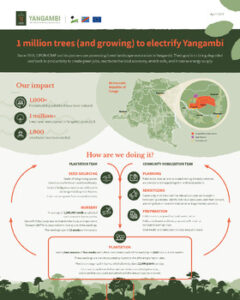Planting trees may seem like a relatively simple task, but much more is required for successful forest landscape restoration.
People and trees have a symbiotic relationship, and local buy-in is an essential part of caring for restored areas and keeping trees in the ground over the long-term as they grow to maturity. Improved living conditions throughout the community are an essential component.
This is one of the many lessons that the field team of the Center for International Forestry Research (CIFOR) and its local partners in Democratic Republic of the Congo (DRC) have learned since 2018 working in the Yangambi Biosphere Reserve, a protected forest area in the north of the country.
 In May of 2021, they celebrated a million planted trees.
In May of 2021, they celebrated a million planted trees.
It’s part of a larger initiative aimed at reactivating Yangambi’s local economy, creating green jobs and increasing land productivity.
Restoration can offer a cost-effective solution to improve livelihoods and meet local energy and nutritional needs.
All of this, while reducing pressure on natural forests.
In this newly published infographic, CIFOR shares the key elements behind the experimental model it has put into place in DRC.
Restoration with a purpose
Forest communities need trees to meet a range of needs, including as a source of food and energy. If natural forests are to be protected, people must be able to access those resources elsewhere.
In Yangambi, most deforestation occurs to meet these essential needs. Each season, local people further encroach on forests, burning them to create more farmland for planting crops and access wood fuel. Not only do people need firewood to prepare meals, but producing charcoal to sell to residents of the nearby city of Kisangani, which has a population of over 2 million people, is a major economic activity and source of revenue. Sustainable development efforts therefore require agricultural intensification and improved energy production on already degraded land.
Technically sound solutions, such as alternating crops and agroforestry, must occur with the full engagement and consent of land users, which means demonstrating the potential benefits of new techniques or behavior changes in areas owned by local innovators willing to engage. As people observe the advantages, they are likely to adopt improved techniques.
It is also important to consider other socio-economic factors. In the case of Yangambi, for example, fruit and caterpillar-bearing trees are surely needed to improve diets, and high-value indigenous tree species might bring in much-needed income. But due to tenurial issues linked to those planting choices, locals initially prefer to plant fast-growing, high-calorific trees to fulfil their short-term energy needs. Improved diets and long-term income must of course remain primary objectives, but if imposed, they might not lead to the expected results. And here is where local engagement becomes key.
Restoration with and for the people
Restoration work in Yangambi never stops. Although trees are only planted during the two rainy seasons that occur each year, preparations are underway year-round.
While a “technical” team made up of community members led jointly by CIFOR, DRC’s National Institute for Agronomic Study and Research (INERA) and R&SD enterprise, takes care of sourcing , preparing tree nurseries, and all the other logistical arrangements, a “mobilization” team blends in with the community throughout the year. This means daily discussions take place, aimed at jointly selecting the plots to be restored, understanding tenure issues (identifying customary owners, users and outsiders with land access rights), mapping and agreeing on limits to avoid conflicts, recruiting planters and other support staff with consent from families, local chiefs and authorities, and ensuring that the purpose of the activities – and both advantages and responsibilities – is clear to everyone involved.
Engagement must continue well after trees have been planted, as teams of local “fire-fighters” are created and organized to protect planted areas from bush fires – a major threat to their survival – and to ensure that light innovations such as regular clearing of fields continue over time.
One of the main short-term benefits for the local population is job creation and increased disposable income. Each season, more than 500 people are employed. Through landscape restoration, a new livelihood alternative to supplement incomes while introducing new ways to understand and work the land is plausible.
Restoration through agroforestry
Most farmland in Yangambi is degraded and harvests are low – a major burden for subsistence farmers. To address these issues, a nitrogen-fixing tree species such as Acacia auriculiformis can be integrated into agricultural rotations, together with improved varieties of seeds, supported by additional activities such as honey production or animal husbandry. For a few years – until they start reaping the benefits of trees as biomass – as they become more experienced, farmers can use a combination of options to increase their yields and profits.
To help build capacity, farmers have access to demonstration plots where they can observe various practices in environments similar to their own farms, learn and ask questions about the techniques that best suit their needs. Demonstration plots are run as extension services, which means that local staff can also follow farmers when they implement options in their own fields, learning and exchanging knowledge.
Ultimately, although the individual ingredients for success are generally known, any restoration recipe must be adapted for the specific landscape in question, taking people and their environment into consideration. In other words, although the principles of landscape restoration are the same, what works in Yangambi might not be the solution elsewhere.
However, it is important for scientists and extension agents to continuously learn from and adapt to this experience to further support successful forest landscape restoration in DRC and elsewhere on the African continent.
Illustration courtesy of CIFOR/Papy Basikaba.
This article by Ahtziri Gonzalez and Paolo Cerutti originally appeared on the CIFOR website. Reprinted here by permission.

